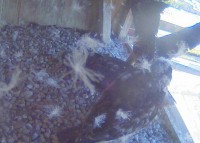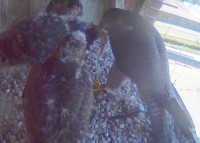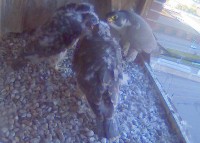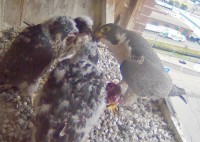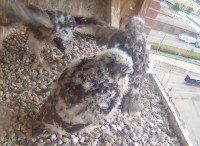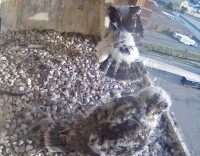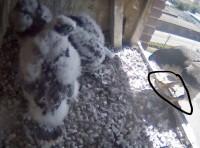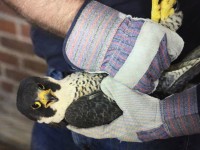Just after sunrise at 5:06 AM, the peregrines chicks started another beautiful morning under fair skies, wind from the SW at 13MPH, and temp at 70F. The day ahead forecast calls for increasing clouds, with a high near 79. West wind around 15 mph, with gusts as high as 28 mph.
By day 32, the patches of remaining down feathers are becoming restricted to the base of the legs, parts of the wings, and perhaps parts of the back, as well as the crown. They are also becoming increasingly vocal and active around the nest area, to the extent that the adults rarely visit except to drop off food for them.
 At about 3:46 this afternoon, the female returned to the nest with fresh prey. The chicks were fed over a 12 minute period before the female hopped back out onto the perch pole, the feeding session completed. The oldest of the three, has the darkest back and fewest remaining bits of down on its back and elsewhere. Over the next few days, the wing flapping, and jumping around the box will increase substantially!
At about 3:46 this afternoon, the female returned to the nest with fresh prey. The chicks were fed over a 12 minute period before the female hopped back out onto the perch pole, the feeding session completed. The oldest of the three, has the darkest back and fewest remaining bits of down on its back and elsewhere. Over the next few days, the wing flapping, and jumping around the box will increase substantially!
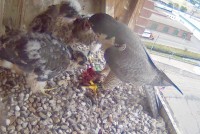 The second photo shows the nearest chick ducking low and trying to grab the prey, while the back chick is opening wide for a big bite! The calling for food, by the chicks, increases in strength as the young grow, and this call, develops into a wail similar to the parent’s call; and this call can be heard from quite a distance, perhaps even a mile away. Parental creaking noises on arrival with food, increases as the young mature. In the second half of the overall 40 day nestling period, a youngster consumes quite large amounts of food and its intake eventually exceeds that of an adult of the same sex!
The second photo shows the nearest chick ducking low and trying to grab the prey, while the back chick is opening wide for a big bite! The calling for food, by the chicks, increases in strength as the young grow, and this call, develops into a wail similar to the parent’s call; and this call can be heard from quite a distance, perhaps even a mile away. Parental creaking noises on arrival with food, increases as the young mature. In the second half of the overall 40 day nestling period, a youngster consumes quite large amounts of food and its intake eventually exceeds that of an adult of the same sex!
Literature cited:
Ratcliffe, D. 1993. The Peregrine Falcon. 2nd ed. Carlton, England: T. and A. D. Poyser.
The Canadian Peregrine Foundation, Peregrine Falcon Development – Age Guide; http://www.peregrine-foundation.ca/info/ageguide.html
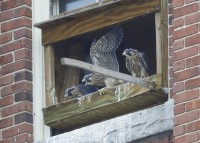 The peregrine chicks and adults were very active around the Ayer Mill Clock Tower late Monday afternoon. The chicks were moving around non-stop and wing flapping with added energy. The adults made a large number of aerial loops around the Clock Tower under mostly cloudy skies, winds from SW at 14MPH and gusts up to 21mPH, and temp at 89F! The adults seemed to be in a playful mode and made a number of mock combat moves, but never making contact.
The peregrine chicks and adults were very active around the Ayer Mill Clock Tower late Monday afternoon. The chicks were moving around non-stop and wing flapping with added energy. The adults made a large number of aerial loops around the Clock Tower under mostly cloudy skies, winds from SW at 14MPH and gusts up to 21mPH, and temp at 89F! The adults seemed to be in a playful mode and made a number of mock combat moves, but never making contact. Finally, the female made a number of final loops and then landed on the outside perch pole and remained for a while!
Finally, the female made a number of final loops and then landed on the outside perch pole and remained for a while!
